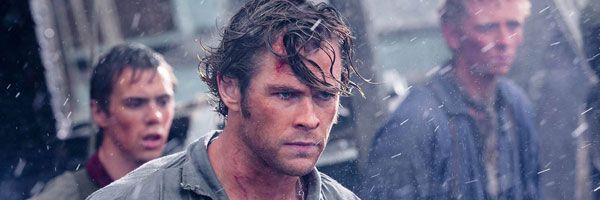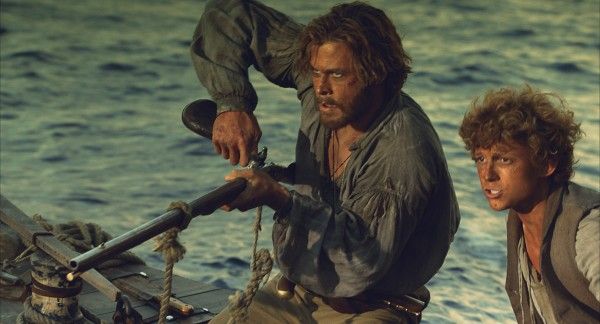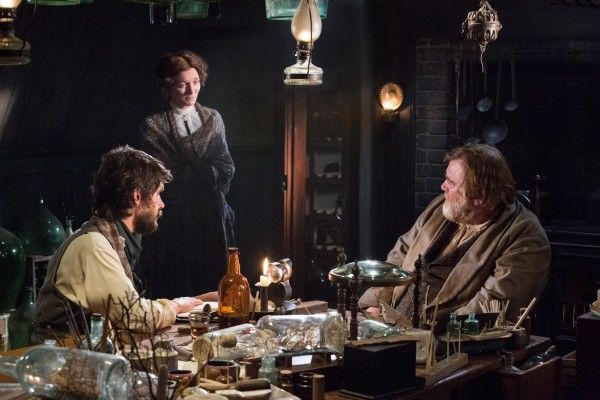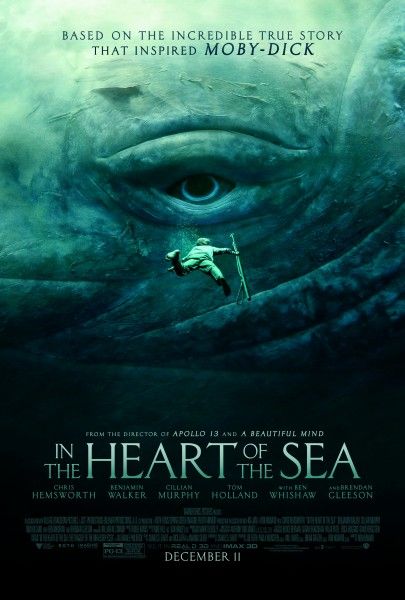Nathaniel Philbrick’s In the Heart of the Sea is one of the best books I’ve read in the past several years. I’m a history nerd, and he makes the details of Nantucket’s whaling industry, centered around the tragic 1820 sinking of the whale ship Essex, absolutely fascinating. While a straight film adaptation doesn’t need the details about how a whaling town functions or the other parts that made the book come alive, Ron Howard’s adaptation seems primarily focused on what would connect with his audience—the name Moby Dick. And yet while this provides a tidy framing device for the narrative, he never takes it any deeper. There’s a bit about PTSD and the dangers of pursuing non-renewable energy resources, but when it comes to a gripping tale, Howard seems as adrift as his characters.
In 1850, author Herman Melville (Ben Whishaw) comes to speak with old tavern owner Thomas Nickerson (Brendan Gleeson) about what happened when Nickerson was a cabin boy on the whale ship Essex in 1820. We flash back to see a young Tom Nickerson (Tom Holland), and we’re told this is a story about two men—the untested Captain George Pollard (Benjamin Walker), who was from a prestigious whaling family, and his experienced first mate Owen Chase (Chris Hemsworth), who is hungry to get his first captaincy. Both men are eager to prove themselves, but their conflicting personalities and backgrounds put them in a vulnerable position when a mammoth whale attacks. Left shipwrecked in the middle of the Atlantic Ocean, the men must resort to desperate means to survive.
In the Heart of the Sea doesn’t do anything particularly wrong, but it doesn’t do anything noteworthy either outside of Anthony Dod Mantle’s tremendous cinematography, which always finds surprising angles and lighting no matter the conditions. The visuals can make even the wide expanse of the sea feel claustrophobic and disoriented as we’re attached to a mast or rigging or some other unexpected perspective. It’s a film that can excite, but never keep you enraptured like Howard’s previous survival tale, Apollo 13. The director seems more enamored of the ocean setting and how it inspired Moby Dick rather than tell his own story. The result is we get broad outlines for Chase and Pollard, but don’t dig any deeper into their relationship, class conflicts, or anything worthwhile, and it’s up to Hemsworth and Walker’s admirable performances to make us care about the characters.
Howard’s film skims along the surface—and while it’s a very pretty, very pristine surface—it’s also odd that Howard’s attention is so focused on what exists outside of a gripping tale. He basically reduces the whale into a recurring symbol (and convenient set piece) for nature’s wrath, and loses most of the human story in the process. What remains comes off as maudlin or tone deaf (there’s one moment between the elderly Thomas Nickerson and his wife that had the audience at my screening laughing). The director knows how to bring us into the thrills of a seafaring tale, but not how to keep us on board with real human drama.
And that’s a shame because there’s much more to In the Heart of the Sea than the story behind the story of Moby Dick. The film doesn’t need to be a history lesson, but there are times when it goes out of its way to avoid rich dramatic material presented in Philbrick’s book. Like his characters after their boat is smashed, Howard doesn’t seem to have much idea of where to go. He just wants to make sure he makes a comment about energy dependence (something dropped in so clumsily you can almost hear him talking about it at the press junket) and then sets the audience on its way. In the Heart of the Sea may not be completely heartless, but Howard should have been able to bring more verve and energy to this tale.
Rating: B-




